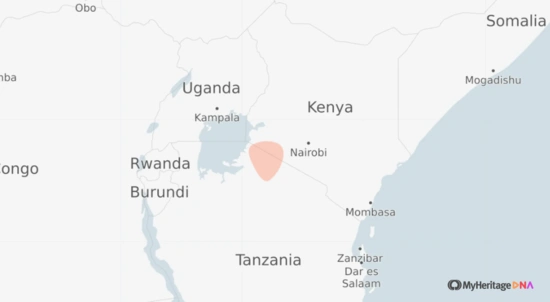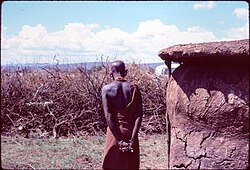
The Maasai are an ethnic group living in southern Kenya and northern Tanzania on the Swahili Coast of East Africa. According to their own traditional lore, the Maasai are descendants of people who migrated to the region from the lower Nile Valley some 500 years ago — a story corroborated by their genetic Nilotic heritage. The Maasai inhabit the African Great Lakes region, and are particularly well known among Westerners due to their residence near popular game parks in Kenya and Tanzania. Traditionally, the Maasai are pastoralists who raise cattle, although many Maasai have moved away from semi-nomadism to a settled life. The Maasai — numbering approximately two million people across Kenya and Tanzania — practice their own faith, although many Maasai identify as Muslims, Christians, or irreligious.
Maasai historyMaasai history

The Maasai trace their history to a region roughly corresponding to southern South Sudan and northwest Kenya. According to Maasai oral history, their ancestors began migrating south from the lower Nile Valley north of Kenya’s Lake Turkana around the fifteenth century, before arriving in their current area sometime between the seventeenth–eighteenth centuries. Many of the tribes and ethnic groups who were settled in the region prior to the arrival of the Maasai were either displaced or assimilated, with the Maasai adopting certain cultural traits from their neighbors, such as ritual circumcision and age-based rather than descent-based social stratification.
By the mid-nineteenth century, the Maasai were spread across a large stretch of land covering almost all of the Great Rift Valley and adjacent lands. During that period, the Maasai were fully-nomadic pastoralists, wandering in bands and subsisting almost entirely on the meat, milk, and blood of the cattle herds they reared. The Maasai were renowned warriors who used spears and shields, as well as throwing clubs — called orinka — which a skilled Maasai warrior could throw accurately to a distance of 100 meters.

Between the 1880s and the early twentieth century, rinderpest decimated the Maasai herds, while smallpox and starvation took a devastating toll on the people, killing between one-half and two-thirds of the Maasai population. The period is known in Maa as Emutai, literally meaning “to wipe out.” Treaties between the Maasai and the British government in Kenya in 1904 and 1911 evicted the Maasai from nearly 60% of their territories and turned over the land to ranchers and wildlife preserves. Throughout the century, more and more lands were taken from the Maasai to create wildlife reserves and national parks, including the famous Maasai Mara (named after the Maasai people) and Serengeti National Park in Tanzania.
Starting in the second half of the twetieth century, the Maasai were put under increasing pressure to abandon their nomadic lifestyle and become settled. Other displaced ethnic groups in Tanzania introduced food cultivation to the Maasai, and they adopted a mixed livelihood. A ban by the Tanzanian government in 1975 on cultivation in the Ngorongoro Conservation area put pressure on the Maasai to participate in the nation’s monetary economy, but the ban was lifted in 1992. Today, many Maasai have integrated into urban society in Kenya and Tanzania. Nevertheless, whether urbanized or rural, traditional Maa culture remains a central part of Maasai identity.
Maasai cultureMaasai culture
The traditional dwelling of the Maasai is the kraal, an outer enclosure of houses surrounding an inner enclosure for livestock. The Maasai kraal consists of a ring of mud-dung houses encircled by a thornbush fence, accommodating up to eight families and their herds. All of the Maasai’s nutritional needs are supplied by their cattle: they drink their milk, eat their meat, and occasionally also drink their blood. This traditional diet has left its mark, with recent DNA studies pointing to a genetically-linked high tolerance for lactose among the Maasai.

In the past, cattle rustling from other tribes was common practice among Maasai who held the belief that God (a dual-natured single deity called Enkai or Engai) gave all the cattle on Earth to the Maasai, who are thus allowed to simply take back their property. Maasai culture is centered around a system of age-sets, starting from junior warriors, through senior warriors, junior elders, and finally senior elders. Between the ages of fourteen and thirty, young Maasai men are known as morans and spend this period in isolation in the bush, learning tribal customs and developing the character traits of a Maasai warrior.
The group is known for its intricate and colorful jewelry and for the impressive adumu jumping dance of Maasai warriors. Ceremonial events are directed by a ritual expert called an oloiboni, who — while holding no political power — is the religious head of his people.
Maasai languagesMaasai languages
The Maasai’s native language is Maa, an Eastern Nilotic language closely related to other varieties spoken in the region, like Samburu in Kenya and Parakuyu in Tanzania. In fact, the name Maasai refers to people “who speak Maa.” The rise of Swahili as a regional lingua franca has challenged the prevalence of Maa among the Maasai. However, as language forms an inseparable part of Maasai culture, Maa retains its importance among its native speakers.
Explore more about ethnicity estimatesExplore more about ethnicity estimates
- MyHeritage DNA at MyHeritage
- Ethnicities around the world at MyHeritage
- What Is My Ethnicity? How MyHeritage Estimates Ethnicities at MyHeritage Knowledge Base
- Where's My Ethnicity?!: Why An Ethnicity Might Not Show Up In Your DNA (and How To Find Evidence Of It Anyway) at MyHeritage Knowledge Base


